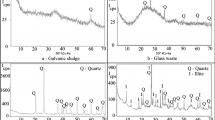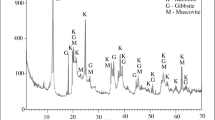Abstract
In an attempt to find ways to reduce consumption of natural raw material and recycle chrysotile tailing waste (CTW), cordierite ceramics were produced using CTW, kaolin tailing waste (KTW) and waste alumina. Before synthesizing the cordierite ceramics, the inert transformation of CTW was investigated via a thermal treatment. Experimental results indicated that CTW was converted into nonhazardous forsterite and enstatite at temperatures above 1000 °C. The characterizations of the synthesized cordierite ceramics were examined using thermal analyses, X-ray diffraction (XRD), morphological structure analyses, compressive strength measurement, coefficient of thermal expansion (CTE) and toxicity characteristic leaching procedure (TCLP). Thermal analyses indicated that significant weight loss below 900 °C was the release of structural water and gases. XRD indicated that the cordierite became the main crystalline phase at 1350 °C. Compressive strength test indicated that compressive strength of the cordierite ceramics was 260 MPa, and CTE of cordierite ceramics was 2.4 × 10−6 °C−1. This technology for the of utilization of CTW and KTW could be used to produce industrial cordierite ceramics, in accordance with the concepts of sustainable development.









Similar content being viewed by others
References
Sophie K, Thompson, Eileen mason (2002) Asbestos: mineral and fibers. Chem Health Saf 7:21–23
Subramanian V, Madhavan N (2005) Asbestos problem in India. Lung Cancer 49:9–12
Giantomassi G, Gualtieri AF, Santarelli L, Tomasetti M, Lusvardi G, Lucarini G, Governa M, Pugnaloni A (2010) Biological effects and comparative cytotoxicity of thermal transformed asbestos-containing materials in a human alveolar epithelial cell line. Toxicol In Vitro 24:1521–1531
Erdinc M, Erdinc E, Cok G, Polatli M (2003) Respiratory impairment due to asbestos exposure in brake-lining workers. Environ Res 91:151–156
Tong F (2005) Worries of asbestos mining resources situation in China. China Build Mater 9:51–52
Malcolm R, Langer AM, Nord GL, Nolan RP, Lee RJ, Orden VD, John Addison J (2008) The mineral nature of asbestos. Regul Toxicol Pharmacol 52:26–30
Du GX (2007) Advancement of the research on the synthesis utility of asbestos tailing. China Non Met Min Ind Her 2:14–17
Bocchetta M, Di Resta I, Powers A (2000) Human mesothelial cells are unusually susceptible to simian virus 40-mediated transformation and asbestos cocarcinogenicity. Proc Natl Acad Sci USA 97:10214–10219
Yang H, Bocchetta M, Kroczynska B (2006) TNF-alpha inhibits asbestos-induced cytotoxicity via a NF-kappaB dependent pathway, a possible mechanism for asbestos induced oncogenesis. Proc Natl Acad Sci USA 103:10397–10402
Zucali PA, Ceresoli GL, Vincenzo D, Simonelli M, Lorenzi E, Gianoncelli L, Santoro A (2011) Advances in the biology of malignant pleural mesothelioma. Cancer Treat Rev 1:1–16
Bernstein DM, Hoskins JA (2006) The health effects of chrysotile: current perspective based upon recent data. Regul Toxicol Pharmacol 45:252–264
Chen ZX, Chen SP, Zhang LZ (2008) Ten year retrospective study on malignant tumor in workers exposed to asbestos dust in an asbestos mine. Chin Occup Med 5:391–393
Alessandro F, Giacobbe GC, Sardisco L, Saraceno M, Gualtieri ML, Lusvardi G, Cavenati C, Zanatto I (2011) Recycling of the product of thermal inertization of cement–asbestos for various industrial applications. Waste Manage (Oxford) 31:91–100
Leonelli C, Veronesi P, Boccaccini DN, Rivasi MR, Barbieri L, Andreola F, Lancellotti I, Rabitti D, Pellacani GC (2006) Microwave thermal inertisation of asbestos containing waste and its recycling in traditional ceramics. J Hazard Mater B135:149–155
Anastasiadou K, Axiotis D, Gidarakos E (2010) Hydrothermal conversion of chrysotile asbestos using near supercritical conditions. J Hazard Mater 179:926–932
Cecchi E, Mercier G, Bergeron M (2009) A feasibility study of carbochlorination of chrysotile tailings. Int J Miner Process 93:278–283
Yanagisawaa K, Kozawaa T, Ondaa A, Kanazawab M, Shinoharab J, Takanamib T, Shiraishi M (2009) A novel decomposition technique of friable asbestos by CHClF2-decomposed acidic gas. J Hazard Mater 163:593–599
Chen J, Zhao JL (2009) The comprehensive utilization of kaolin. J Dongguan Univ Technol 16:94–97
Menezes RR, Brasileiro MI, Gonçalves WP, Santana LND, Neves GA, Ferreira HS, Ferreira HC (2009) Statistical design for recycling kaolin processing waste in the manufacturing of mullite-based ceramics. Mat Res 12:201–209
Brasileiro MI, Rodrigues AWB, Menezes RR, Neves GA, Santana LNL (2012) The kaolin residue and its use for production of mullite bodies. In: Ghenai C (ed) Sustainable development-energy, engineering and technologies-manufacturing and environment. InTech, pp 117–142. ISBN: 978-953-51-0165-9. Available from: http://www.intechopen.com/books/sustainable-development-energy-engineering-and-technologies-manufacturing-and-environment/the-kaolin-residue-and-its-use-for-production-of-mullite
Brasileiro MI, Oliveira DHS, Lira HL, Santana LNL, Neves GA, Novaes AP (2006) Mullite preparation from kaolin residue. Mater Sci Forum 530–531:625–630
Liang WB, Zhao W, Yang HM (2011) New progress on high-efficiency exploitation and utilization of kaolin tailings. Multipurp Util Miner Resour 4:6–10
Kobayashi Y, Sumi K, Kato E (2000) Preparation of dense cordierite ceramics from magnesium compounds and kaolinite without additives. Ceram Int 26:739–743
Tulyaganov DU, Tukhtaev ME, Escalante JI, Ribeiro MJ, Labrincha JA (2002) Processing of cordierite based ceramics from alkaline-earth-aluminosilicate glass, kaolin, alumina and magnesite. J Eur Ceram Soc 22:1775–1782
Kumar S, Singh KK, Ramachadrarao P (2000) Synthesis of cordierite from fly ash and its refractory properties. J Mater Sci Lett 19:1263–1265
Menchi AM, Scian AN (2005) Mechanism of cordierite formation obtained by the sol–gel technique. Mater Lett 59:2664–2667
Gonzalez-Velasco JR, Gutierrez-Ortiz MA, Ferret R (1993) Synthesis of cordierite monolithic honeycomb by solid state reaction of precursor oxides. J Mater Sci 34:1999–2002
Naskar MK, Chatterjee M (2004) A novel process for the synthesis of cordierite (Mg2Al4Si5O18) powders from rice husk ash and other sources of silica and their comparative study. J Eur Ceram Soc 24:3499–3508
Goren R, Gocmez H, Ozgur C (2006) Synthesis of cordierite powder from talc, diatomite and alumina. Ceram Int 32:407–409
Zhou JE, Dong YC, Hampshire S, Meng GY (2011) Utilization of sepiolite in the synthesis of porous cordierite ceramics. Appl Clay Sci 52:328–332
Shieh YN, Rawlings RD, West RF (1995) Constitution of laser melted Al2O3–MgO–SiO2 ceramics. Mater Sci Technol 11:863–869
Ghitulica C, Andronescu E, Nicola O, Dicea A, Birsan M (2007) Preparation and characterization of cordierite powders. J Eur Ceram Soc 27:711–713
Douy A (1992) Synthesis of cordierite powder by spray drying. J Non Cryst Solids 147:554–558
Gopichandran R, Patil KC (1993) Combustion synthesis, characterisation, sintering and microstructure of cordierite. Br Ceram Trans 92:239–245
Banjuraizaha J, M H, Ahmadb ZA (2009) Crystal structure of single phase and low sintering temperature of α-cordierite synthesized from talc and kaolin. J Alloy Compd 482:429–436
Guo RX, Zou JR, Gui BL (2009) Stabilization/solidification of heavy metals in sludge ceramics and leachability affected by oxide substances. Environ Sci Technol 43:5902–5907
Yan QX (2010) Research on structure and performance of kaolin and calcined kaolin from different regions. Non Met Mines 33:9–11
Acknowledgments
The authors are grateful for support of key personnel in the Shanghai Municipality (S30109), the Opening Project of Key Laboratory of Solid Waste Treatment and Resource Recycle (SWUST), Ministry of Education (12zxgk09) and Shanghai Science and Technology Commission (10dz1205302).
Author information
Authors and Affiliations
Corresponding author
Rights and permissions
About this article
Cite this article
Zhu, P., Wang, L.Y., Hong, D. et al. Investigative studies for inert transformation of toxic chrysotile tailing. J Mater Cycles Waste Manag 15, 90–97 (2013). https://doi.org/10.1007/s10163-012-0093-6
Received:
Accepted:
Published:
Issue Date:
DOI: https://doi.org/10.1007/s10163-012-0093-6




